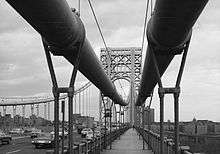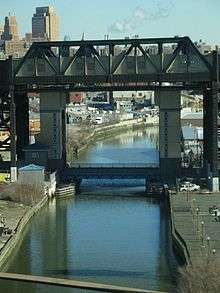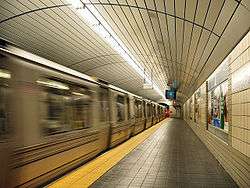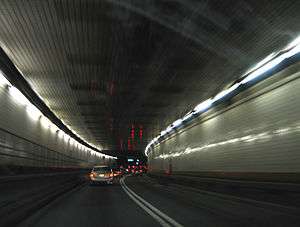List of bridges and tunnels in New York City

New York City is home to over 2,000 bridges and tunnels. Several agencies manage this network of crossings, including the New York City Department of Transportation, Metropolitan Transportation Authority, Port Authority of New York and New Jersey, New York State Department of Transportation and Amtrak.
Many of the city's major bridges and tunnels have broken or set records. The Holland Tunnel was the world's first vehicular tunnel when it opened in 1927. The Brooklyn Bridge, Williamsburg Bridge, George Washington Bridge, and Verrazano–Narrows Bridge were the world's longest suspension bridges when opened in 1883,[1] 1903,[2] 1931,[3] and 1964[4] respectively.
Bridges
New York's crossings date back to 1693, when its first bridge, known as the King's Bridge, was constructed over Spuyten Duyvil Creek between Manhattan and the Bronx, located in the present-day Kingsbridge neighborhood. The bridge, composed of stone abutments and a timber deck, was demolished in 1917. The oldest crossing still standing is High Bridge, built 1848 to carry the Croton Aqueduct from Manhattan to the Bronx over the Harlem River.[5] This bridge was built to carry water to the city as part of the Croton Aqueduct system.
Ten bridges and one tunnel serving the city have been awarded some level of landmark status. The Holland Tunnel was designated a National Historic Landmark in 1993 in recognition of its pioneering role as the first mechanically ventilated vehicular underwater tunnel, operating since 1927. The George Washington, High Bridge, Hell Gate, Queensboro, Brooklyn, Manhattan, Macombs Dam, Carroll Street, University Heights, and Washington bridges have all received landmark status, as well.[5]
New York features bridges of all lengths and types, carrying vehicular, bicycle, pedestrian, and subway traffic. The George Washington Bridge, spanning the Hudson River between New York City and Fort Lee, New Jersey, is the world's busiest bridge in terms of vehicular traffic.[6][7] The George Washington, Verrazano–Narrows, and Brooklyn are noted for their architecture, while others are more well known for their functional importance, such as the Williamsburg Bridge with 8 vehicular lanes, 2 subway tracks, a bike lane, and pedestrian walkways.
Bridges by water body
East River


From south to north:
| Name | Opening year | Length | Carries | Comments |
|---|---|---|---|---|
| Brooklyn Bridge | 1883 | 1,825 metres (5,988 ft) | 6 lanes of roadway (3 in each direction) | Oldest suspension bridge. Also oldest suspension/cable-stayed hybrid bridge. |
| Manhattan Bridge | 1909 | 2,089 metres (6,854 ft) | 7 lanes of roadway and B D N Q trains | Double-decker bridge with 5 westbound lanes and 2 eastbound lanes. 3 of the westbound lanes and the subway are below the other 4 lanes. |
| Williamsburg Bridge | 1903 | 2,227.48 metres (7,308.0 ft) | 8 lanes of roadway (4 in each direction) and J M Z trains | |
| Ed Koch Queensboro Bridge | 1909 | 1,135 metres (3,724 ft) | 9 lanes of | Also known as 59th Street Bridge. Reversible 4 lanes on the upper deck, and 2 westbound/3 eastbound lanes on the lower deck. |
| Roosevelt Island Bridge | 1955 | 876.91 metres (2,877.0 ft) | 2 lanes of roadway (1 in each direction) | East channel only |
| Triborough Bridge (Suspension Bridge) | 1936 | 850 metres (2,790 ft) | 8 lanes of | Officially known as the Robert F. Kennedy Bridge |
| Hell Gate Bridge | 1916 | 5,181.6 metres (17,000 ft) | 3 rail tracks (2 of Northeast Corridor, 1 of New York Connecting Railroad) | |
| Rikers Island Bridge | 1966 | 1,280.16 metres (4,200.0 ft) | 2 lanes of roadway | Only connects Rikers Island to Queens |
| Bronx–Whitestone Bridge | 1939 | 1,149.10 metres (3,770.0 ft) | 6 lanes of | |
| Throgs Neck Bridge | 1961 | 886.97 metres (2,910.0 ft) | 6 lanes of |
Harlem River
From south to north, east to west:
| Name | Opening year | Length | Carries | Comments |
|---|---|---|---|---|
| Wards Island Bridge | 1951 | 285.6 metres (937 ft) | Pedestrians and bicycles only | |
| Triborough Bridge (Vertical-Lift Bridge) | 1936 | 230 metres (750 ft) | 2 lanes of exit ramp from F.D.R. Drive | Officially known as the Robert F. Kennedy Bridge |
| Willis Avenue Bridge | 1901 | 979 metres (3,212 ft) | 4 lanes of roadway | Northbound traffic only |
| Third Avenue Bridge | 1898 | 853.44 metres (2,800.0 ft) | 5 lanes of roadway | Southbound traffic only |
| Park Avenue Bridge | 1956 | 100 metres (330 ft) | 4 tracks of Metro-North | |
| Madison Avenue Bridge | 1910 | 577 metres (1,893 ft) | 4 lanes of roadway | |
| 145th Street Bridge | 1905 | 489 metres (1,604 ft) | 4 lanes of roadway | |
| Macombs Dam Bridge | 1895 | 774 metres (2,539 ft) | 4 lanes of roadway | |
| High Bridge | 1848 | 600 metres (2,000 ft) | Pedestrian walkway and bicycle lanes | Oldest surviving bridge in New York City |
| Alexander Hamilton Bridge | 1963 | 724 metres (2,375 ft) | 8 lanes of | |
| Washington Bridge | 1888 | 723.9 metres (2,375 ft) | 5 lanes of roadway | |
| University Heights Bridge | 1908 | 82 metres (269 ft) | 2 lanes of roadway | |
| Broadway Bridge | 1962 | 170.08 metres (558.0 ft) | 4 lanes of Broadway/ | Also known as Harlem Ship Canal Bridge |
| Henry Hudson Bridge | 1936 | 673 metres (2,208 ft) | 6 lanes of | Double-decked bridge |
| Spuyten Duyvil Bridge | 1899 | 186 metres (610 ft) | 1 track of Empire Corridor | Swing bridge |
Hudson River


| Name | Opening year | Length | Carries | Comments |
|---|---|---|---|---|
| George Washington Bridge | 1931 | 1,450.85 metres (4,760.0 ft) | 14 lanes of | Double-deck, 8 lanes on upper level, 6 lanes on lower level. 7 lanes in each direction. |
New York Bay
| Name | Opening year | Length | Carries | Comments |
|---|---|---|---|---|
| Verrazano-Narrows Bridge | 1964 | 2,039.1 metres (6,690 ft) | 12 lanes of | Double-deck, 6 lanes on each level. 6 lanes in each direction. |
Newtown Creek
| Name | Opening year | Length | Carries | Comments |
|---|---|---|---|---|
| Kosciuszko Bridge | 1939 | 1,835 metres (6,020 ft) | 6 lanes of | Replacement in construction |
| Pulaski Bridge | 1954 | 860 metres (2,820 ft) | 6 lanes of McGuinness Boulevard | Drawbridge |
| J. J. Byrne Memorial Bridge | 1987[8] | 55 metres (180 ft) | 4 lanes of Greenpoint Avenue | a.k.a. Greenpoint Avenue Bridge Drawbridge |
| Grand Street Bridge | 1903[8] | 69.2 metres (227 ft) | 1 lane of Grand Avenue | Swing bridge; one-lane bridge |
| Metropolitan Avenue Bridge | 1933[8] | 33.8 metres (111 ft) | 4 lanes of Grand Street and Metropolitan Avenue | Drawbridge; Crosses English Kills, a tributary of Newtown Creek[8] |
Other
The Bronx
| Name | Opening year | Length | Carries | Comments | |
|---|---|---|---|---|---|
| Bronx Kill | |||||
| Robert F. Kennedy Bridge (Truss bridge) | 1936 | 490 metres (1,610 ft) | 8 lanes of | Formerly known as the Triborough Bridge | |
| Hutchinson River (heading downriver) | |||||
| Eastchester Bridge | 1926 | 0.4 miles | 4 lanes of Boston Road ( | ||
| I-95 bridge | 1917 | 5,280 feet | 6 lanes of | ||
| Hutchinson River Parkway Bridge | 1941 | 205 metres (673 ft) | 6 lanes of | Drawbridge | |
| Hutchinson River Bridge | 1908 | 81 feet (25 m) | Northeast Corridor (Amtrak) | Also called Amtrak Pelham Bay Bridge | |
| Pelham Bridge | 1908 | 272 metres (892 ft) | 4 lanes of Shore Road | Drawbridge | |
| Westchester Creek | |||||
| Unionport Bridge | 1953 | 160.3 metres (526 ft) | 7 lanes of | ||
| Bronx River | |||||
| Eastern Boulevard Bridge | 1953 | 193.2 metres (634 ft) | Drawbridge | ||
| Eastchester Bay | |||||
| City Island Bridge | 1901 | 290 metres (950 ft) | 3 lanes of City Island Avenue | ||
Brooklyn

| Name | Opening year | Length | Carries | Comments |
|---|---|---|---|---|
| Gowanus Canal | ||||
| Union Street Bridge | 1905[9] | 600 feet | 2 lanes of Union Street | Drawbridge |
| Carroll Street Bridge | 1889[9] | 300 feet | 2 lanes of Carroll Street | New York City Designated Landmark and one of four retractable bridges in the country[10] |
| Third Street Bridge | 1905[9] | 350 feet | Third Street | |
| Ninth Street Bridge | 1999[9] | 700 feet | Ninth Street | |
| Culver Viaduct | 1938[11] | 0.6 miles | IND Culver Line (F G trains) | |
| Hamilton Avenue Bridge | 1942[9] | 0.7 miles | Hamilton Avenue | |
| Gowanus Expressway | 1941[12] | 9 lanes of | ||
| Mill Basin | ||||
| Mill Basin Bridge | 1963 | 0.8 miles | 6 lanes of | |
| Rockaway Inlet (Brooklyn and Queens) | ||||
| Marine Parkway–Gil Hodges Memorial Bridge | 1937 | 1226 m | 4 lanes of Flatbush Avenue | |
Queens
| Name | Opening year | Length | Carries | Comments |
|---|---|---|---|---|
| Dutch Kills | ||||
| Borden Avenue Bridge | 1908[8] | 100 feet | 2 lanes of Borden Avenue | One of four retractable bridges in the country[10] |
| Hunters Point Avenue Bridge | 1910[8] | 500 feet | Hunters Point Avenue | |
| Jamaica Bay | ||||
| Cross Bay Veterans Memorial Bridge | 1970 | 0.7 miles | 6 lanes Cross Bay Boulevard | |
| The Joseph P. Addabbo Memorial Bridge | 1971 | 0.7 miles | 6 lanes of Cross Bay Boulevard | |
| North Channel Swing Bridge | (A train) | Not actually a movable bridge. Howard Beach to Broad Channel. | ||
| Beach Channel Drawbridge | (A S trains) | Broad Channel to The Rockaways | ||
| 102nd Street Bridge | Connecting Hamilton Beach at Russell Street with Howard Beach, also known as "Lenihan's Bridge". | |||
| Hawtree Creek Bridge | 163rd Avenue and 99th Street in Howard Beach across to Hamilton Beach at Rau Court and Davenport Court | |||
| Rockaway Inlet (Brooklyn and Queens) | ||||
| Marine Parkway-Gil Hodges Memorial Bridge | 1937 | 1226 m | 4 lanes of Flatbush Avenue | |
Staten Island
| Name | Opening year | Length | Carries | Comments |
|---|---|---|---|---|
| Arthur Kill | ||||
| Goethals Bridge | 1928 | 2164.08 m | 4 lanes (2 very tight lanes in each direction) of | Being replaced. |
| Arthur Kill Vertical Lift Bridge | 1959 | 170.08 m | CSX and M&E rail lines | |
| Outerbridge Crossing | 1928 | 3093 m | 3 lanes of | |
| Kill Van Kull | ||||
| Bayonne Bridge | 1931 | 1761.74 m | 2 lanes of | Being raised |
Tunnels
Each of the tunnels that run underneath the East and Hudson Rivers were marvels of engineering when first constructed. The Holland Tunnel is the oldest of the vehicular tunnels, opening to great fanfare in 1927 as the first mechanically ventilated underwater tunnel. The Queens Midtown Tunnel was opened in 1940 to relieve the congestion on the city's bridges. Each of its tubes were designed 1.5 feet (0.46 m) wider than the Holland Tunnel in order to accommodate the wider cars of the period. When the Brooklyn–Battery Tunnel opened in 1950, it was the longest continuous underwater vehicular tunnel in North America, a title it still holds.[13] The Lincoln Tunnel has three tubes linking midtown Manhattan to New Jersey, a configuration that provides the flexibility to provide four lanes in one direction during rush hours, or three lanes in both direction.
All four underwater road tunnels were built by Ole Singstad: the Holland Tunnel's original chief engineer Clifford Milburn Holland died, as did his successor, Milton H. Freeman, after which Singstad became chief engineer, finishing the Holland Tunnel and then building the remaining tunnels.
East River


From south to north:
Harlem River
From south to north:
| Name | Opening year | Length | Carries | Comments |
|---|---|---|---|---|
| Lexington Avenue Tunnel | 1918 | 391 m (1,283 ft) | IRT Lexington Avenue Line (4 5 6 <6> trains) | |
| 149th Street Tunnel | 1905 | 195 m (641 ft) | IRT White Plains Road Line (2 train) | |
| Concourse Tunnel | 1933 | IND Concourse Line (B D trains) |
Hudson River
From south to north:
| Name | Opening year | Length | Carries | Comments |
|---|---|---|---|---|
| Downtown Hudson Tubes | 1909 | 1,720 m (5,650 ft) | Montgomery-Cortlandt Tunnels Port Authority Trans-Hudson | |
| Holland Tunnel | 1927 | south tube: 2,551 m (8,371 ft) north tube: 2,608 m (8,558 ft) | 2 lanes of | |
| Uptown Hudson Tubes | 1908 | 1,700 m (5,500 ft) | Hoboken-Morton Tunnels Port Authority Trans-Hudson | |
| North River Tunnels | 1910 | 1,900 m (6,100 ft) | part of New York Tunnel Extension Amtrak and New Jersey Transit (Northeast Corridor) | |
| Lincoln Tunnel | south tube: 1957 center tube: 1937 north tube: 1945 | south tube: 2,440 m (8,006 ft) center tube: 2,504 m (8,216 ft) north tube: 2,281 m (7,482 ft) | 4 lanes of |
Newtown Creek
| Name | Opening year | Carries | Comments |
|---|---|---|---|
| Greenpoint Tube | 1933 | IND Crosstown Line (G train) |
Bridges and tunnels spanning land only
- Park Avenue Tunnel 1, Park Avenue Viaduct, and Park Avenue Tunnel 2, Manhattan
- Battery Park Underpass, Manhattan
- Cobble Hill Tunnel, Brooklyn
- First Avenue Tunnel from 42nd Street to 47th Street, Manhattan
- Trinity Place Bridge, Manhattan
Bridges and tunnels by use
The relative average number of inbound vehicles between 5 a.m. and 11 a.m. to Midtown and Lower Manhattan is:
- Queensboro Bridge: 31,000
- Lincoln Tunnel: 25,944
- Brooklyn Bridge: 22,241
- Williamsburg Bridge: 18,339
- Queens-Midtown Tunnel: 17,968
- Holland Tunnel: 16,257
- Brooklyn Battery Tunnel: 14,496
- Manhattan Bridge: 13,818
See also
- List of bridges documented by the Historic American Engineering Record in New York
- List of tunnels documented by the Historic American Engineering Record in New York
- List of fixed crossings of the East River
- List of crossings of the Harlem River
- List of fixed crossings of the Hudson River
- List of bridges in Pittsburgh
References
- New York City Department of Transportation (NYCDOT). "Movable Bridges in the Bronx." Accessed 2015-08-25.
- ↑ "NYC DOT - Brooklyn Bridge". Retrieved 2012-02-24.
- ↑ "NYC DOT - Williamsburg Bridge". Retrieved 2012-02-24.
- ↑ "History - George Washington Bridge - The Port Authority of NY & NJ". Retrieved 2012-02-24.
- ↑ "Verrazano-Narrows Bridge". Retrieved 2012-02-24.
- 1 2 "NYC DOT - Frequently Asked Questions about Bridges". Retrieved 2012-02-24.
- ↑ "Port Authority of New York and New Jersey - George Washington Bridge". The Port Authority of New York & New Jersey. Retrieved September 13, 2013.
- ↑ Bod Woodruff; Lana Zak & Stephanie Wash (November 20, 2012). "GW Bridge Painters: Dangerous Job on Top of the World's Busiest Bridge". ABC News. Retrieved September 13, 2013.
- 1 2 3 4 5 6 "Movable Bridges over Newtown Creek and its Tributaries". New York City. Retrieved 20 September 2013.
- 1 2 3 4 5 New York City Dept. of Transportation. "Bridges over the Gowanus Canal". New York City. Retrieved 20 September 2013.
- 1 2 Berger, Joseph (May 13, 2013). "Antique Bridge Closed to Traffic While It's Open for Repairs". New York Times. Retrieved 20 September 2013.
- ↑ McGill, John. "Underline: The Culver Viaduct". Urban Omnibus. Retrieved 20 September 2013.
- ↑
- ↑ "Hugh L. Carey Tunnel (formerly Brooklyn-Battery Tunnel)". MTA Bridges & Tunnels. Retrieved 2015-12-02.
External links
| Wikimedia Commons has media related to |
- Bridge information
- Bridges by use
- NYC DOT list of movable bridges
- Bridges NYC [history of bridges in New York City and surrounding areas]